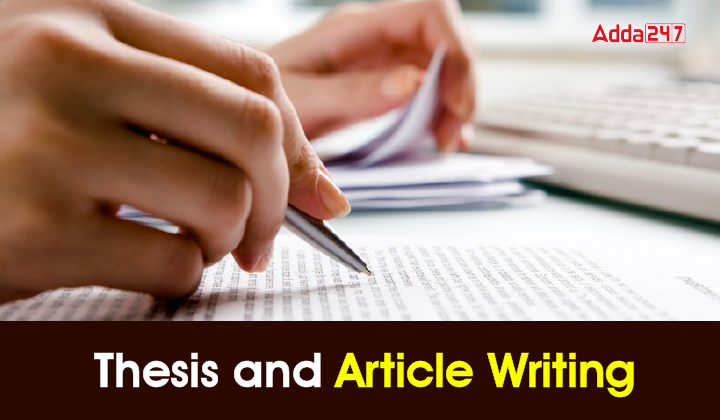Table of Contents
Thesis and article writing are essential aspects of academic discourse, each serving unique roles within the scholarly community. Theses contribute new knowledge to a specific field through in-depth research, while articles disseminate information to a broader audience.
While the former demands a structured, comprehensive approach, the latter prioritizes brevity and accessibility. By understanding the nuances of each form, researchers, scholars, and students can effectively communicate their ideas, contribute to their respective fields, and engage with the broader academic community.
What is Thesis?
The thesis refers to a document submitted in support of candidature for an academic degree or professional qualification (PhD) proposing the author’s research and results of that research. It is important to distinguish between the terms “dissertation” and “thesis” because they are used interchangeably. The major distinction between “dissertation” and “thesis” is the length of dissertations and thesis, where earlier is having shorter length as compared to the latter one. Moreover, dissertations are submitted in the fulfilment of the master’s degree and thesis for the grant of a PhD degree.
What is Article Writing?
Article writing refers to writing meant to deliver information to the masses with the help of media sources like newspapers, magazines, journals, etc. The structure of the research article is simple and brief with compact organisation of different headings. In contrast, thesis and dissertation writing is detailed and hefty.
Thesis and Article Writing Format
The generally accepted format of thesis or report writing tends to be produced in the following way:
| Headings of the format | Subheadings and detail |
|---|---|
| Title of the thesis or article (title page) |
|
| Table of Contents | This section includes the contents of the report, in the form of chapters or in subheadings. |
| List of Tables | This section contains the title and page number of all tables. |
| List of Figures | This section includes the page number of all graphs, pie charts etc |
| Acknowledgements | In this section, the researcher may acknowledge Institute Principal, Faculty Guide, both research guide and research participants, friends etc |
| Introduction | This section orients the research topic with its aims and objectives. |
| Review of Literature | This section contains all your background research obtained from the literature review. |
| Research design | This section includes all practical details followed for research. This includes reporting on data collection, how many people took part, how they were selected, what tools were used for data collection, how the data was analysed etc. |
| Data Analysis and Interpretation | If you have conducted a large quantitative survey, this section may contain tables, graphs, pie charts, and associated statistics. If you have conducted a qualitative piece of research, this section may be descriptive prose. |
| Summary and Conclusion | In this section, you sum up your findings and draw conclusions from them, perhaps in relation to other research or literature. |
| Recommendation | A list of clear recommendations that have been developed from the research is included. |
| Suggestion for Further Research | it shows that you are aware of the wider picture and that you are not trying to cover up something which you feel may be lacking in your own work |
| List of References/Bibliography |
|
Difference between Thesis and Article writing
The major differences between thesis writing and article writing are as follows:
| Basis of difference | Thesis | Article |
| Meaning | It is a document of academic nature and has more detailed content. | It is, however, a shorter document highlighting key points in a more concise format. |
| Need | It serves the academic purpose needs | It serves journalistic needs and required standards. |
| Review | Reviewed by selected committee members | Reviewed by a panel of blind reviewers |
| Division | This is divided into chapters | It is divided into sections |
| Length of literature reviewed | Here, the literature review is lengthy. | Here, the length is precise |
| Type of description | A detailed description of different tools and techniques used during the research is required | Only essential and succinct tools used |
| Presentation of findings | All findings are presented | Selected findings are presented. |
Hence, thesis and article writing are important aspects of the research field. The researcher needs to understand the core in order to frame these in an effective way. Following are the tips that need to be kept in mind while writing a thesis and articles:
- Be as specific as possible
- Start writing early, don’t wait for the deadline to come
- Draft roughly before finalising the whole.
- Use logical sentences and flow.
Download Thesis and Article Writing Study Notes PDF
Below is the direct download link for Thesis and Article Writing Study Notes PDF for UGC NET Exams. Candidates can access and download the Thesis and Article Writing Study Notes PDF for UGC NET Exams from the provided link.
Download Thesis and Article Writing Study Notes PDF
| UGC NET Related Articles | |
| UGC NET Notification 2025 | UGC NET Application Form 2025 |
| UGC NET Previous Year Question Paper | UGC NET Syllabus |




 UGC NET Teaching Aptitude Questions Answ...
UGC NET Teaching Aptitude Questions Answ...
 What is Soil Pollution - Causes, Effects...
What is Soil Pollution - Causes, Effects...
 UGC NET Philosophy Syllabus 2025 PDF Dow...
UGC NET Philosophy Syllabus 2025 PDF Dow...












